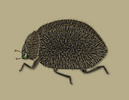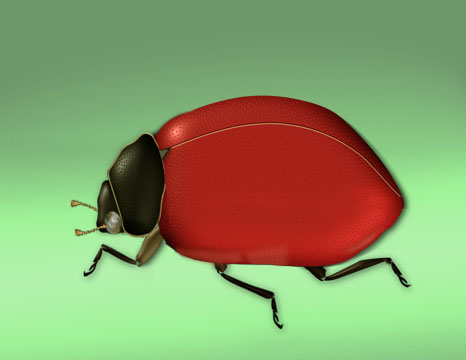Ladybird Beetles
CoccinellidaeSummary 7
The Coccinellidae (/ˌkɒksɪˈnɛlɪdaɪ/) are a family of small beetles, ranging from 0.8 to 18 mm (0.0315 to 0.708 inches). They are commonly yellow, orange, or scarlet with small black spots on their wing covers, with black legs, heads and antennae. Such colour patterns vary greatly, however; for example, a minority of species, such as Vibidia duodecimguttata, a twelve-spotted species, have whitish spots on a brown background. Coccinellids are found worldwide, with over 5,000 species described.
General description 8
Coccinellidae (Lady Beetles, Ladybirds, Lady Bugs)
Lady Beetles are small, round, with convex wing-covers. The head and pronotum are often shiny black with white markings, while the wing-covers are often shiny orange-red with black dots. Some species, however, are predominantly black, or gray with black dots, and may have fine hairs on their bodies. The adults usually feed on aphids, scale insects, and other small insects, while the larvae tend to feed on the same kinds of insects. Adults occasionally appear on flowers with exposed nectaries to feed on nectar. Lady Beetles are considered beneficial insects, although a few species feed on the foliage of crop plants.
Characteristics 9
Lady beetles come in many different colors and patterns. Mouse over the following words to see more examples below: striped, checkered, banded, ocellate, metallic, punctuation marks, inkblot, radial lines.
The charismatic red and black dappled members of the tribe Coccinellini are easily recognized by the layperson, but the family as a whole is somewhat difficult to characterize. Most species can be identified by the broadly rounded to elongate body form with convex dorsum and flattened venter, clubbed antennae, and the presence of a postcoxal line on the first abdominal ventrite (lacking in Paranaemia, Naemia, and Coleomegilla). The tarsal formula of most species is 4-4-4 with the third tarsomere minute and tucked within the broad triangular second (cryptotetramerous or pseudotrimerous), only a few have the tarsomeres more equal (truly tetramerous), and some have tarsi reduced to 3-3-3 (truly trimerous).
It can be difficult to recognize a lady beetle without studying some of its minute morphological features. The majority of species are very small, drab, and pubescent ("furry") like the image below.
 <!-- ToL Image #END# -->
<!-- ToL Image #END# -->
Explore some of the common body types found within the family Coccinellidae by mousing over the numbered legend below. What advantages do these different forms possess? What are their respective vulnerabilities?
More elongate <----1--- -----2----- -----3----- -----4----- ---5----> More compact <!--//hide contents browserName = navigator.appName; // detect browser browserVer = parseInt(navigator.appVersion); if (((navigator.appName == "Netscape") && (parseInt (navigator.appVersion) >= 3)) || ((navigator.appName == "Microsoft Internet Explorer") && (parseInt (navigator.appVersion) >= 4))) version = "n3"; else version = "n2"; if (version == "n3") { menu1mf = new Image (); menu1mf.src = "http://tolweb.org/tree/ToLimages/morph1.jpg"; menu2mf = new Image (); menu2mf.src = "http://tolweb.org/tree/ToLimages/morph2.jpg"; menu3mf = new Image (); menu3mf.src = "http://tolweb.org/tree/ToLimages/morph3.jpg"; menu4mf = new Image (); menu4mf.src = "http://tolweb.org/tree/ToLimages/morph4.jpg"; menu5mf = new Image (); menu5mf.src = "http://tolweb.org/tree/ToLimages/morph5.jpg"; } function img_swap(imgName) { if (version == "n3") { document["place"].src = eval(imgName + "mf.src"); } } // -->
Coccinellids are quite similar to endomychid beetles, but lack a frontoclypeal suture and have the mandibular mola reduced or absent. They also lack the impressed lines on the base of the pronotum which are characteristic of many endomychids.
The family Corylophidae also shares many affinities with Coccinellidae, but Corylophids posess a functional spiracle on abdominal segment 7 (lacking in Coccinellidae), have the galea and lacinia of the mouthparts fused into a single lobe (separate structures in Coccinellidae), and have a distinct form to the male genitalia.
Physical description 10
Adult Lady Beetles are round and small (1-10 mm) long. They are usually colored in some combination of black and red, orange, or yellow, and often have spots on their wing covers. Some species always have the same pattern of colors and spots, but in some species individual beetles can have very different colors. Lady Beetle antennae are short, shorter than the front legs, and are thicker at the ends than the middle. Lady Beetle larvae are also colored in some combination of black and red or orange. They are very active, and have rather rough or bumpy looking bodies that are longer than the adults. Lady Beetle pupae look somewhat like the adults. It is nearly impossible for anybody but experts to tell male Lady Beetles from female ones, and even the experts sometimes can't tell without dissecting the beetle. The bright colors of Lady Beetles are warnings to predators, because all Lady Beetles have toxic chemicals in their blood that makes them taste very bad.
Range length: 1.0 to 10.0 mm.
Other Physical Features: ectothermic ; bilateral symmetry
Sexual Dimorphism: sexes alike
Habitat 11
Lady Beetles live where their prey live. This means on plants, mostly herbs and bushes, but sometimes trees or even grass. Species that live in temperate climates with cold winters sometimes make short migrations to warmer habitats, and many spend the winter hiding under bark or in a crack or crevice.
Habitat Regions: temperate ; tropical ; terrestrial
Terrestrial Biomes: taiga ; chaparral ; forest ; rainforest ; scrub forest ; mountains
Wetlands: marsh ; swamp
Other Habitat Features: urban ; suburban ; agricultural
Sources and Credits
- (c) Cécile Bassaglia, some rights reserved (CC BY-NC-SA), http://www.flickr.com/photos/30063276@N02/3598557968
- (c) Stanislav Krejčík, some rights reserved (CC BY), https://www.biolib.cz/IMG/GAL/39990.jpg
- (c) Gilles San Martin, some rights reserved (CC BY-SA), http://farm9.staticflickr.com/8022/7263755186_44009e41bd_o.jpg
- (c) anonymous, some rights reserved (CC BY-NC), http://www.biopix.com/PhotosMedium/GDR%20Myzia%20oblongoguttata%2009500.jpg
- (c) anonymous, some rights reserved (CC BY-NC), http://www.biopix.com/photos/SDL-Myzia-oblongoguttata-00001.jpg
- (c) Stanislav Krejčík, some rights reserved (CC BY), https://www.biolib.cz/IMG/GAL/78342.jpg
- (c) Wikipedia, some rights reserved (CC BY-SA), http://en.wikipedia.org/wiki/Coccinellidae
- (c) John Hilty, some rights reserved (CC BY-NC), http://eol.org/data_objects/31875154
- (c) <a href="http://tolweb.org/people/3551">Adriano Giorgi</a>, <a href="http://www.ars.usda.gov/pandp/people/people.htm?personid=5794">Natalia Vandenberg</a>, some rights reserved (CC BY-NC), http://eol.org/data_objects/10109476
- (c) The Regents of the University of Michigan and its licensors, some rights reserved (CC BY-NC-SA), http://eol.org/data_objects/25064188
- (c) The Regents of the University of Michigan and its licensors, some rights reserved (CC BY-NC-SA), http://eol.org/data_objects/25064187













